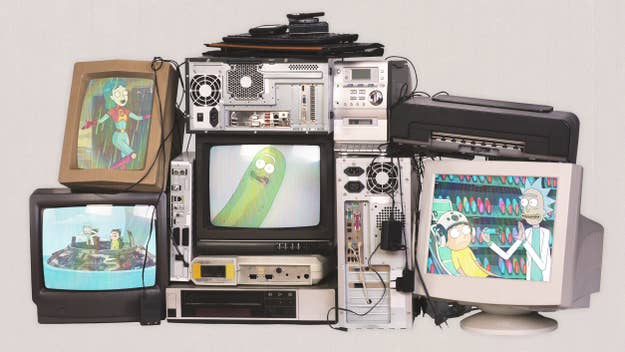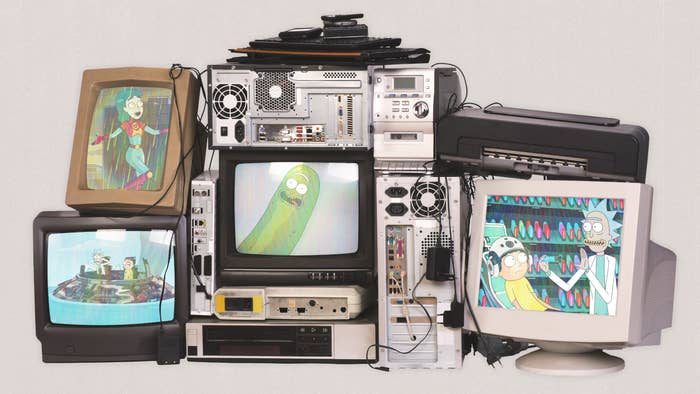
We know this list isn’t going to satisfy everyone, but we tried anyway.
Since its inception in 2013, Rick and Morty has amassed a cult following, quickly carving out a new niche for adult animation and becoming a household staple in the same vein as The Simpsons. For the past decade, the now-seven-season show has helmed several episodes that have become fixtures in pop culture, from iconic one-liners to ceaseless Pickle Rick merch.
With Season 7 premiering, we’ve taken a look back at the show’s past seasons and rounded up the 20 best episodes so far. A quick note: These episodes are listed chronologically by season and not by ranking—stay schwifty.
1. “Meeseeks and Destroy” (Season 1, Episode 5)
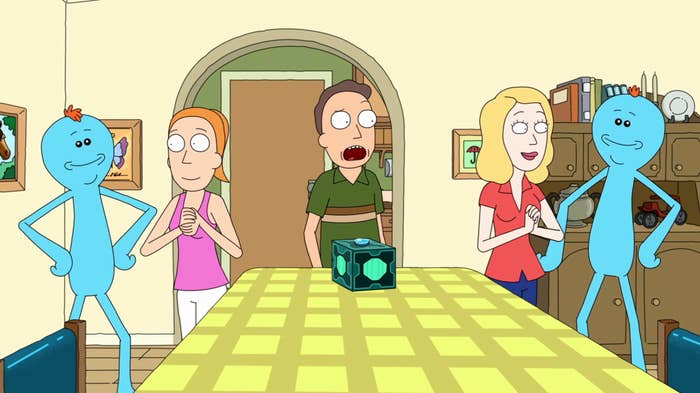
"Meeseeks and Destroy" shows the narrative range that Rick and Morty is capable of. The fact that it occurs a mere five episodes into the series' run demonstrates the writers' ambitions. They were defining their show for their audience, in real time, and they wanted as much room to play as possible. We get existential horror from the Meeseeks. We get family drama from Jerry (Chris Parnell) and Beth (Sarah Chalke). We get a series of escalating, hilarious jokes about Jerry's toothless incompetence, each of which logically progresses from its prior step. And, most jarringly, we get an attempted rape scene that is not played for laughs. When Rick (the now-fired Justin Roiland) deduces what happened, we see his softer side, and he supports his grandson in the best way he knows how. —Kevin Wong
2. “Rick Potion #9” (Season 1, Episode 6)
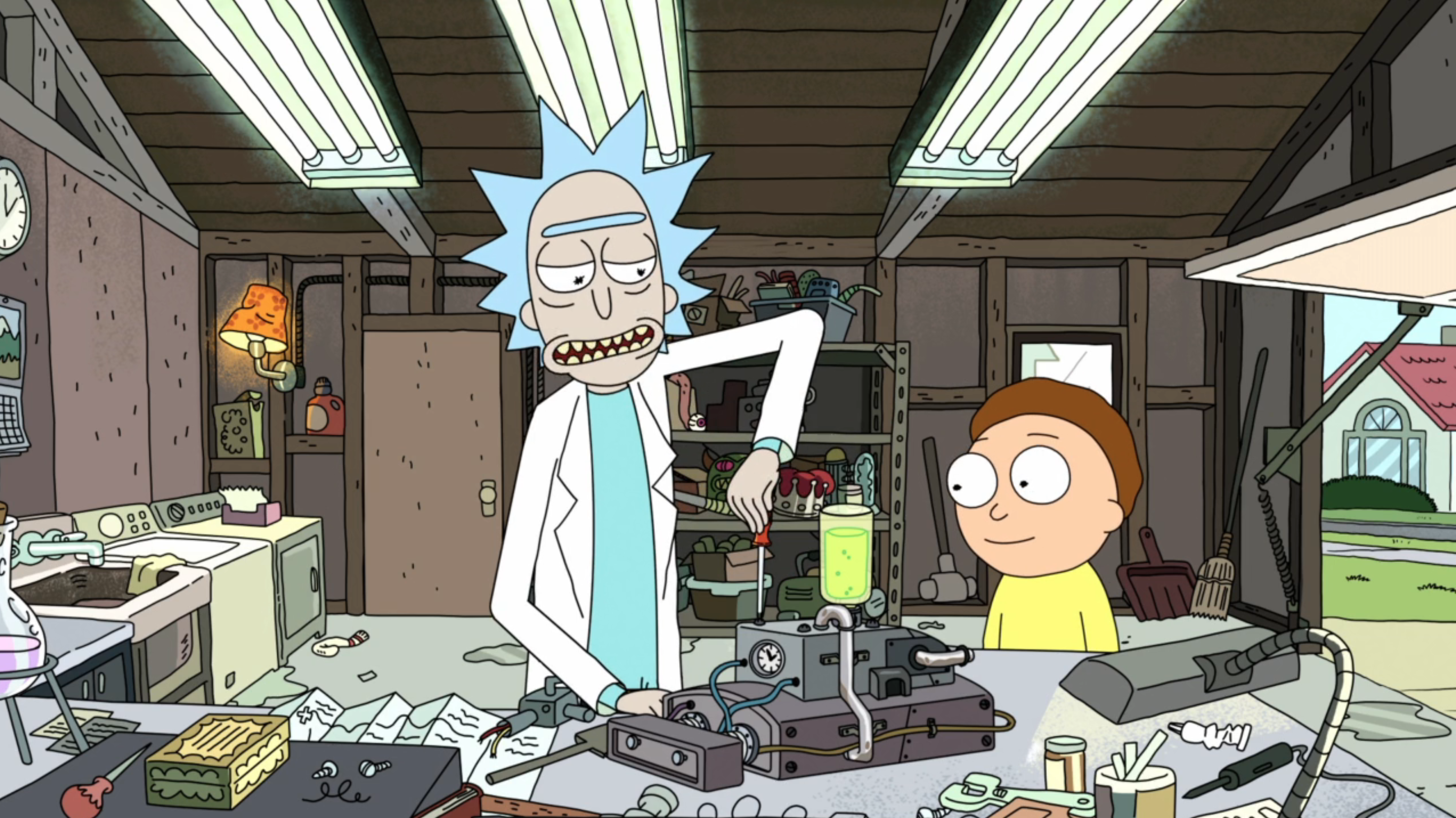
“Rick Potion #9” gets a lot of attention for introducing the multiverse of Rick and Morty, but it serves as one of the earliest executions of a recurring theme throughout the series: What if we took a simple trope and explored the practical, real-world consequences? Morty’s (Roiland) desire to get his love interest, Jessica (Kari Wahlgren), to fall in love with him ends up dooming the planet due to a viral mix-up affecting the world’s population. The ending is a stunner that leans into the show’s penchant for meta-style dark humor—all while seeing through this tried-and-true trope to its logical conclusion. —William Goodman
3. “Total Rickall” (Season 2, Episode 4)
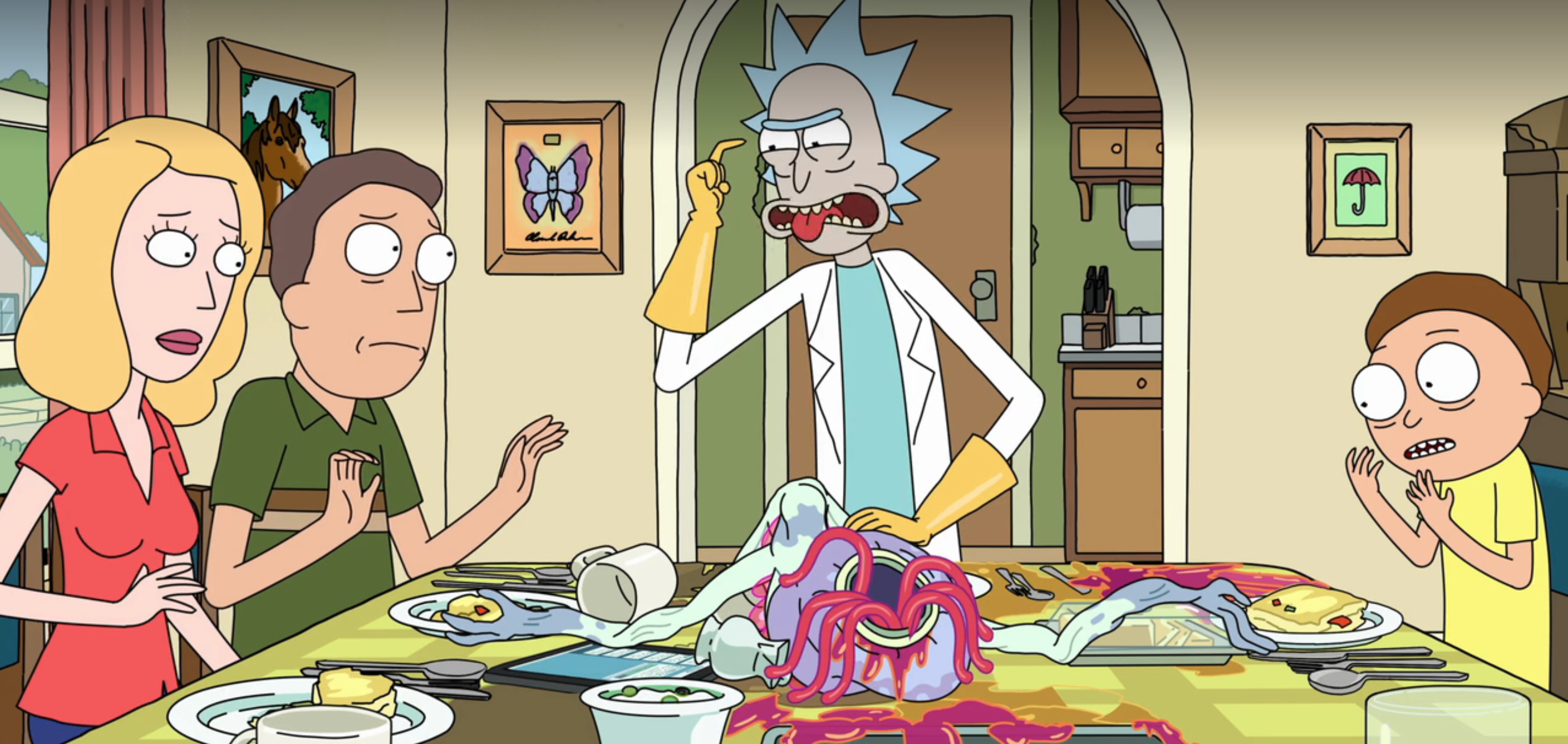
A bizarre meta episode, even by the show's standards, "Total Rickall" depicts a wide range of mayhem within a single, mundane setting. Instead of jumping across the multiverse to strange new worlds, Rick imprisons his family in their home because there are alien parasites living amongst them. They have implanted false memories into everyone's brains to hide in plain sight, and by the end of the episode, the living room is packed with ancillary characters. The best thing about the episode is how it involves us—the viewer—who, with the benefit of a third-person perspective, can more plainly see how the parasite slowly gains hold and manipulates the family. The episode also introduces Mr. Poopybutthole, who has become one of the show's most popular inside jokes. —Kevin Wong
4. “Big Trouble in Little Sanchez” (Season 2, Episode 7)
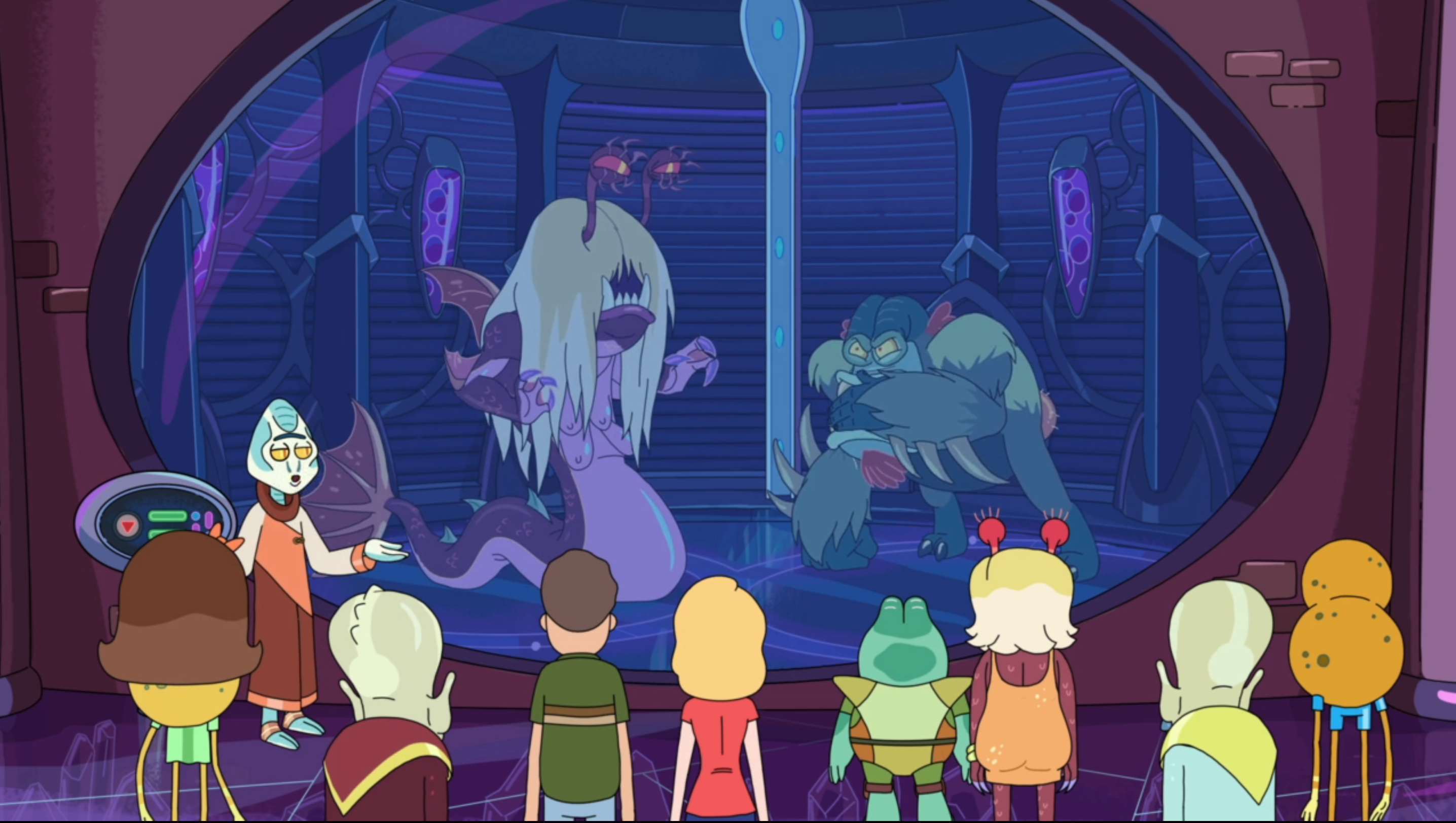
Rick transports his consciousness into a younger body of himself, in order to protect Morty and Summer (Spencer Grammer) from bloodthirsty vampires. Meanwhile, Jerry and Beth try to work out their marital issues at an intergalactic therapy retreat, where they see visual projections of how they view each other (spoiler: It is as literal as it is horrifying). The science fiction genre is highly dependent upon rules, and how the participants can bend those rules (but never break them) to achieve their objectives. As crazy as things get in "Big Trouble in Little Sanchez," the writers always adhere to their internal logic, and they even manage to squeeze in an existential endorsement of singer/songwriter Elliott Smith. —Kevin Wong
5. “Interdimensional Cable 2: Tempting Fate” (Season 2, Episode 8)
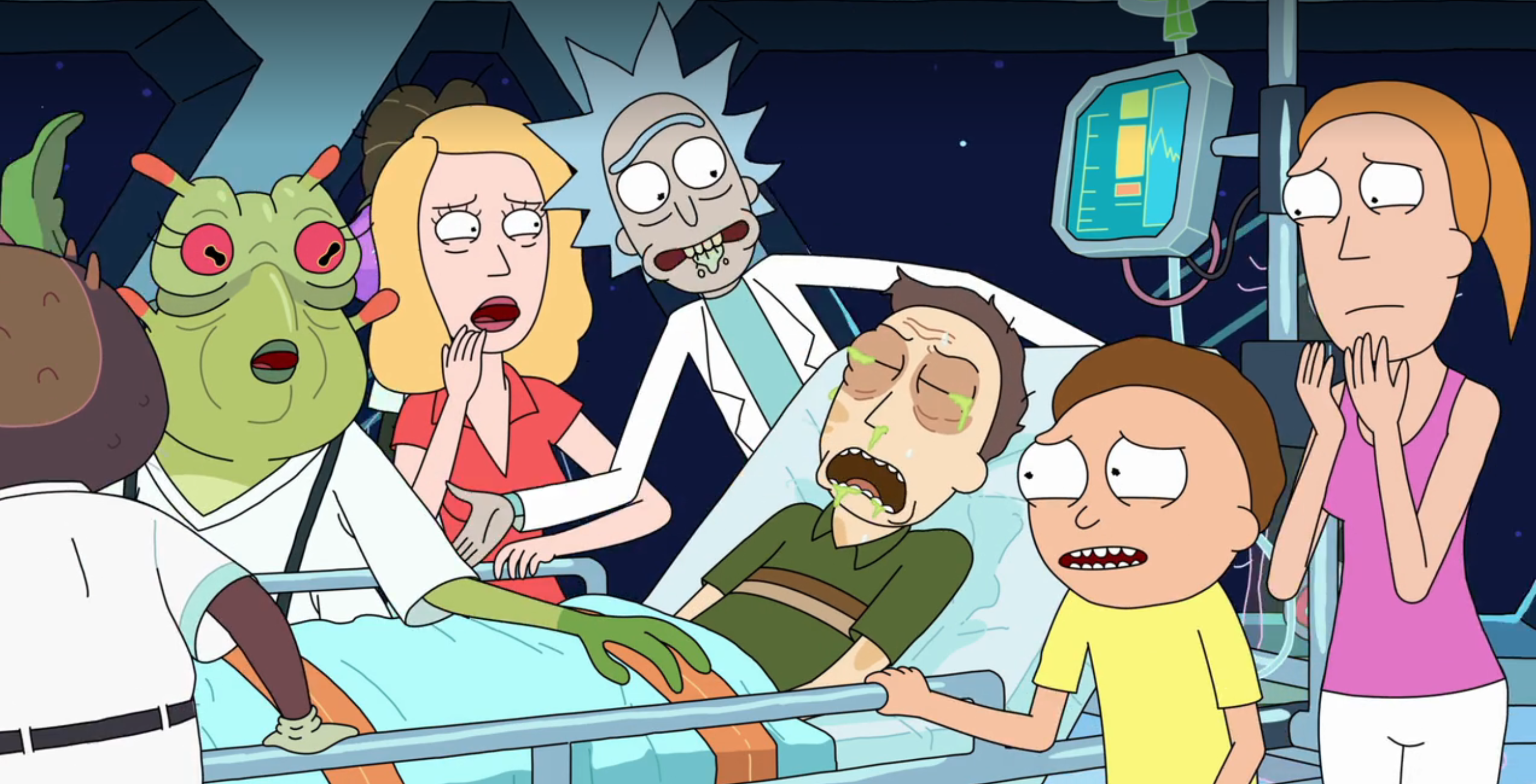
Interdimensional cable is one of the many running bits that we see throughout the entirety of the Rick and Morty series. But it’s the second episode solely dedicated to it during Season 2 that sticks out above the rest. What really sets this particular episode apart is what’s going on outside the Smiths watching cable from around the universe, and that’s Jerry dealing with an internal conflict that no one else cares about—a consistent theme we often see throughout Rick and Morty’s many seasons. “Interdimensional Cable 2” is so great because it lets the minds behind the show flex their creativity in ways that don’t pertain to the series’ usual players. There is a mixture of original content as well as hilarious spoofs from characters and shows in the real world, the likes of Gazorpazorpfield, Jan Quadrant Vincent, and more. —Ben Felderstein
6. “The Rickshank Rickdemption” (Season 3, Episode 1)
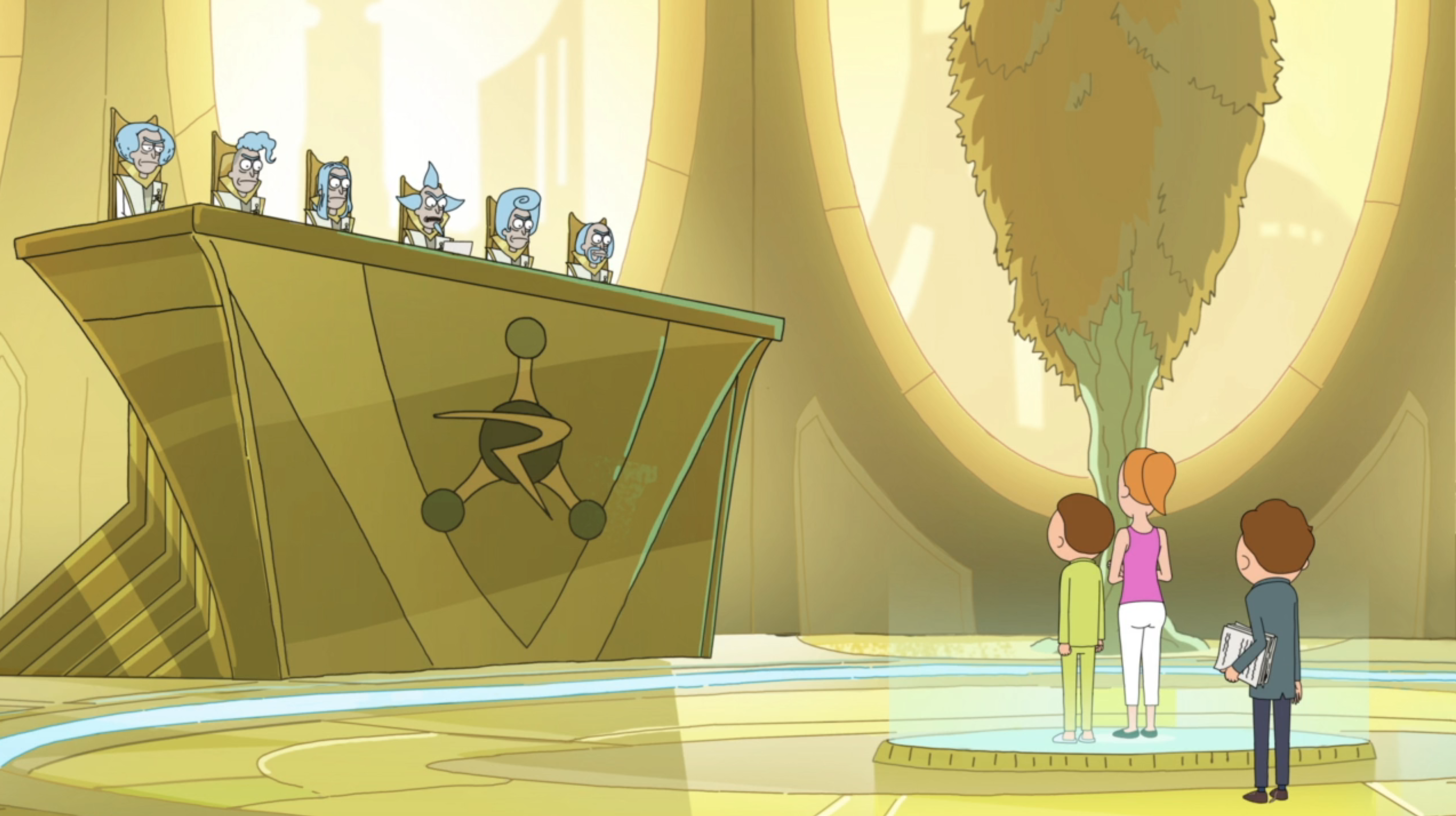
Season 2 ended on a cliffhanger. The Galactic Federation colonized Earth. Rick abandoned the family in a misguided attempt to be less selfish, and turned himself into space prison for his numerous intergalactic crimes. But in the Season 3 premiere, "The Rickshank Redemption," Rick breaks out of prison to save his family and overthrow the Galactic Federation. This leads to some truly inspired action sequences, in which Rick transports his consciousness from one body to another, in order to outfox his enemies—both the Galactic Federation and the SEAL Team Ricks—and prevent them from killing him. The end is incredibly dark. Is Rick actually that petty and evil? Or is he just trying to save face in his own deluded way? This episode is so creative, so filled with clever twists and self-referential turns, that a 22-minute episode feels like a full-length, two-hour movie. And we wouldn’t have it any other way. We could watch an episode like this one for hours. —Kevin Wong
7. “Pickle Rick” (Season 3, Episode 3)
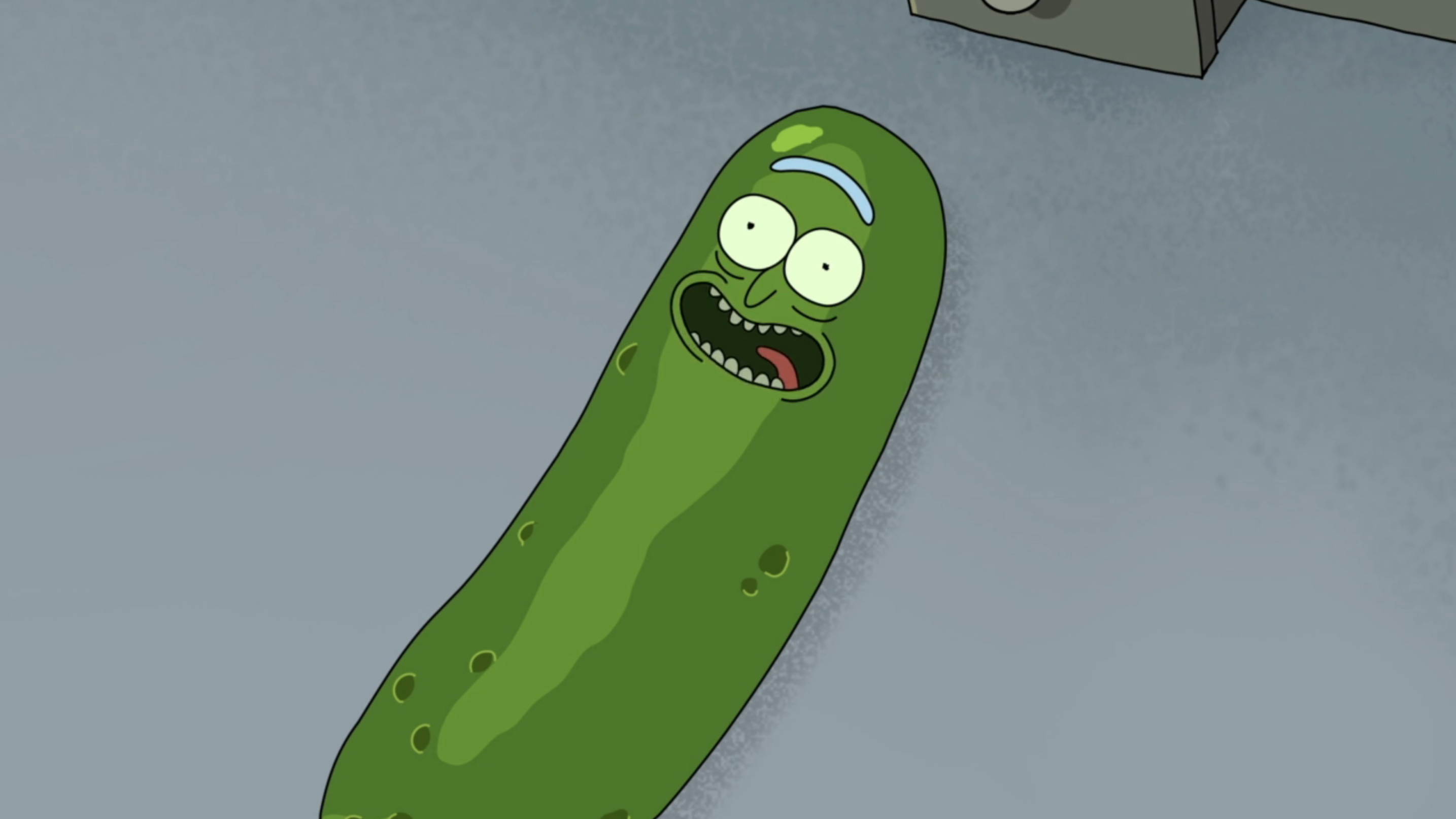
Like all the best episodes of Rick and Morty, "Pickle Rick" works on multiple levels. It has an absurd adventure premise where Rick turns himself into a pickle, falls into a sewer, and must improvise to return to his human form. "Pickle Rick" has some of the series' best animated action. But it's also a little family-focused drama where the Smiths, spurred by Jerry and Beth's impending divorce, confront their busted dynamic. It's a damning portrait of Beth in particular; it's a given that Rick is touched in the head, but the family therapy session really takes Beth to task for how she enables and propagates the insanity around her. The episode also ends with an anti-climax. There's a brief moment where Beth and Rick could have learned something profound, but it's quickly swept under the rug. Knowing the ugly truth and acting upon it are two different things. —Kevin Wong
8. “Vindicators 3: The Return of Worldender” (Season 3, Episode 4)

Rick and Morty get a distress call from The Vindicators, a tropey superhero team of which they are members. Rick is the genius of the group, of course, and Morty is the audience stand-in, who is supposed to ooh, ahh, and gawk over everyone else’s abilities. Of course, it all goes off the rails in a hurry. And the final supervillain they must defeat is Rick, who traps the group (including himself!) in a massive, Saw-inspired series of contraptions that he rigged while he was black-out drunk. And sadly, that’s when Morty gets to shine. Because nobody knows Black-Out Drunk Rick better than his teenage grandson. —Kevin Wong
9. “The Ricklantis Mixup” (Season 3, Episode 7)
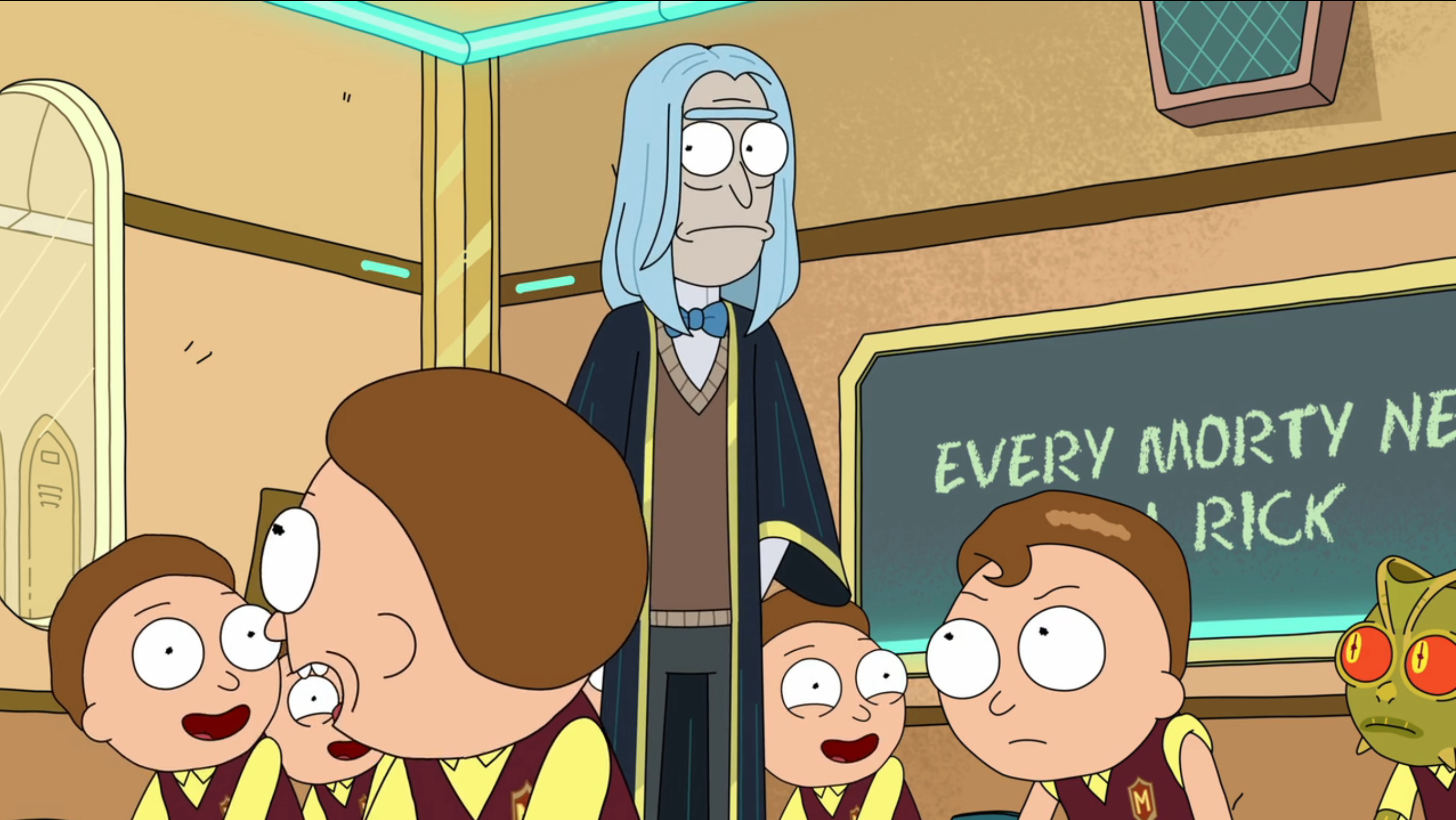
Any episode that features The Citadel of Ricks is an awesome episode in my book. While the citadel is a bit confusing and often leaves you with far more questions than it does answers, it is always hilarious seeing countless Ricks interacting with one another, often killing one another, and always trying to outsmart another Rick. While an election is taking place between a number of Ricks, and even one Morty, as the citadel is being rebuilt, our Ricky and Morty (maybe? I don’t know—who knows how many times they’ve been replaced) are on their own journey to Atlantis. The meta humor inside of the citadel is some of the best work throughout the series, as we see the dynamic between its two main characters acted out on an unfathomably large scale. There’s President Morty, Lizard Morty, Glasses Morty, Left-Handed Morty, and many, many more variants in this multiversal adventure. —Ben Felderstein
10. “Morty’s Mind Blowers” (Season 3, Episode 8)

Expectations are always tricky to contend with, but the best episodes of Rick and Morty arrive when the show plays peek-a-boo with the audiences’ preconceived notions. To wit, “Morty’s Mind Blowers” appears to be a spiritual successor to the beloved installments of “Interdimensional Cable” before heading down an otherwise deeply traumatizing path. To keep Morty functioning in a state of arrested development, Rick takes memories of otherwise deeply messed-up events from their travels and stores them in glass vials—at Morty’s request. This revelation eventually leads to discovering that squirrels (!) control the world, and the pair moves into another reality, furthering the series’ take on the multiverse. The heady philosophical questions are there for those who want to dive into the deep end, but “Mind Blowers” stands out in the way it manages hilarity, absurdity, and dark humor with ease, taking the simple idea of memory wiping and turning it into an episode you’ll never forget. —William Goodman
11. “Edge of Tomorty: Rick Die Rickpeat” (Season 4, Episode 1)
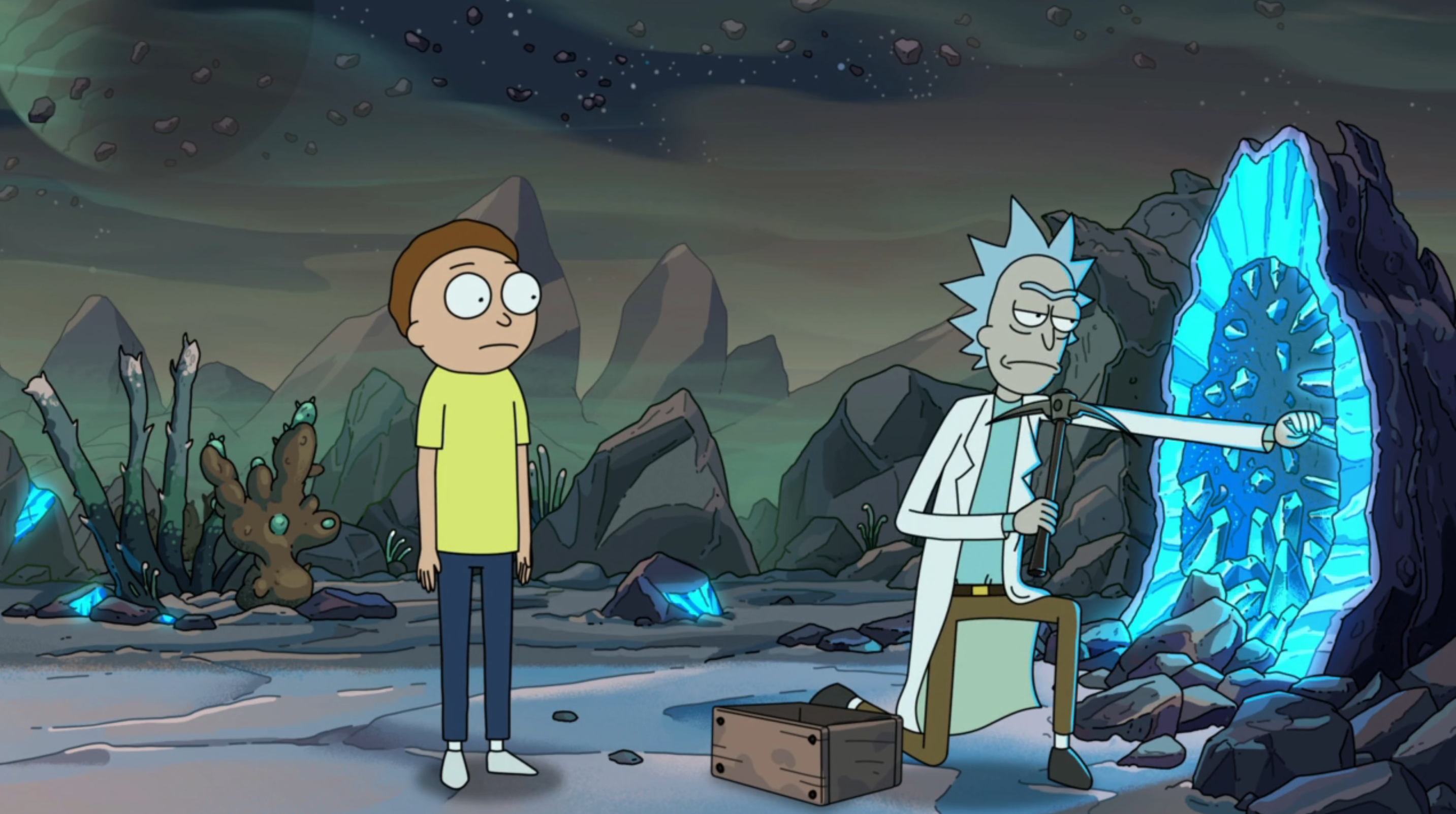
“Edge of Tomorty” isn’t the last episode of Rick and Morty to be inherently indebted to anime, but it’s one of the more blatantly inspired riffs. Loosely inspired by both Akira and All You Need Is Kill (itself adapted into the Tom Cruise/Emily Blunt action movie Edge of Tomorrow), the fourth season premiere is a bit of a back-to-basics installment that follows a familiar flow: An insane sci-fi concept is introduced, and the show executes it to a logical conclusion. This time, the stakes are a little more personal as Morty finds a crystal that shows him a future with his crush, Jessica. The catch? It’ll only happen if he decides not to revive a now-dead Rick. Of course, Rick has a backup plan for this, which involves him teleporting his consciousness to a series of clone bodies throughout the multiverse, thus drawing out the Edge of Tomorrow comparisons while Morty’s psychic powers draw out the Akira side of things. Action-packed and absurdly hilarious, “Edge” proved that the two-year wait between the third and fourth seasons was well worth it—and that the creative team hadn’t slipped in their ability to deliver a memorable episode this far into the series’ run. —William Goodman
12. “One Crew Over the Crewcoo’s Morty” (Season 4, Episode 3)
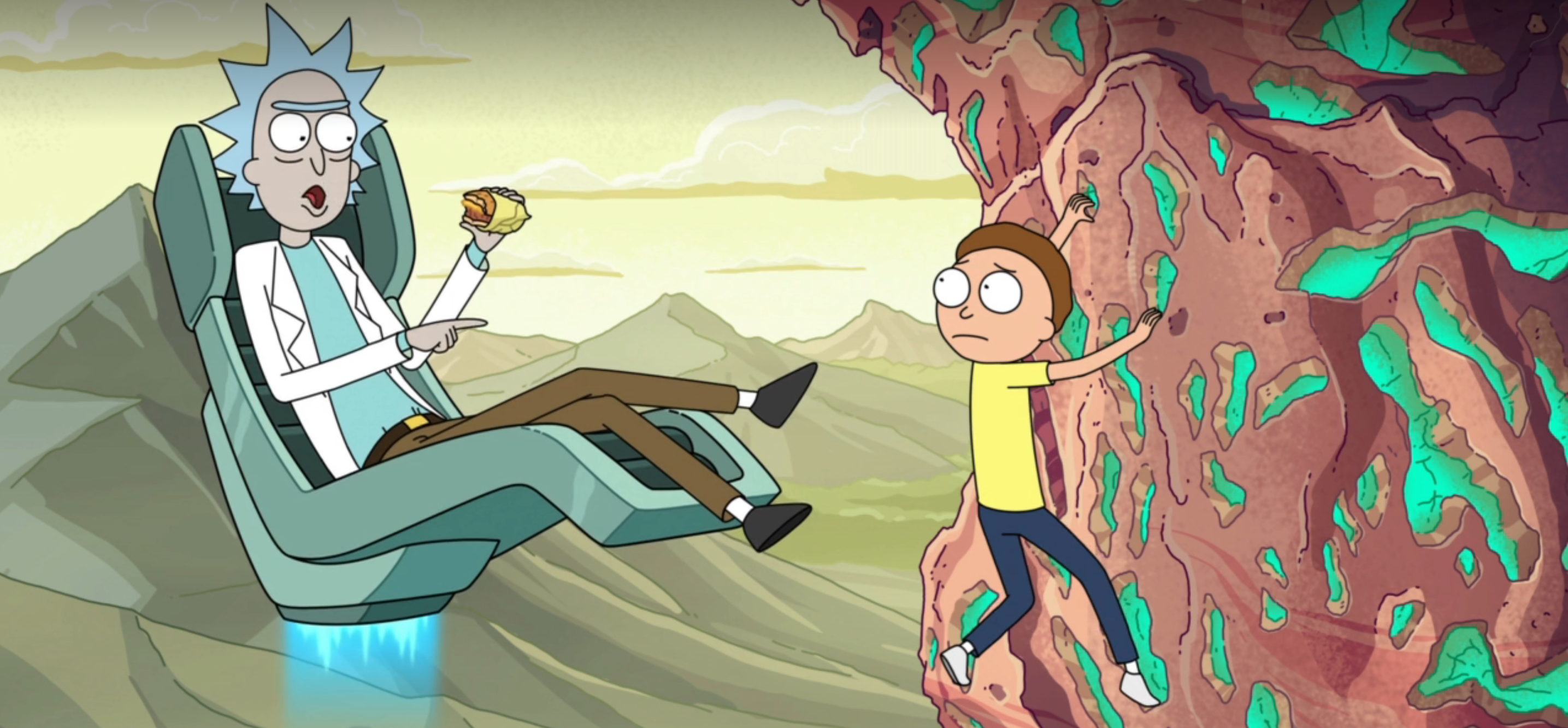
One of my absolute favorite tropes in television is a team-up episode. There’s corny montages. There’s characters we don’t always see or hear from. And there’s some ridiculous group adventure involved. Something that Rick and Morty has always done brilliantly is steer directly into age-old tropes and give them a signature spin—which is exactly what goes down in “One Crew Over the Crewcoo’s Morty.” During the episode, Rick and Morty need to assemble a crew to break into a heist convention and put an end to a heist-planning robot. The episode’s cleverly layered and packed to the brim with twists, turns, heists of course, and deception. It also has a bit of real-world existentialism tied in, with Rick and the robot arguing for two hours, leading to its self-destruction and realization that there is no perfect heist. A parallel to AI, maybe? I’ll let you be the judge. —Ben Felderstein
13. “Rattlestar Ricklactica” (Season 4, Episode 5)
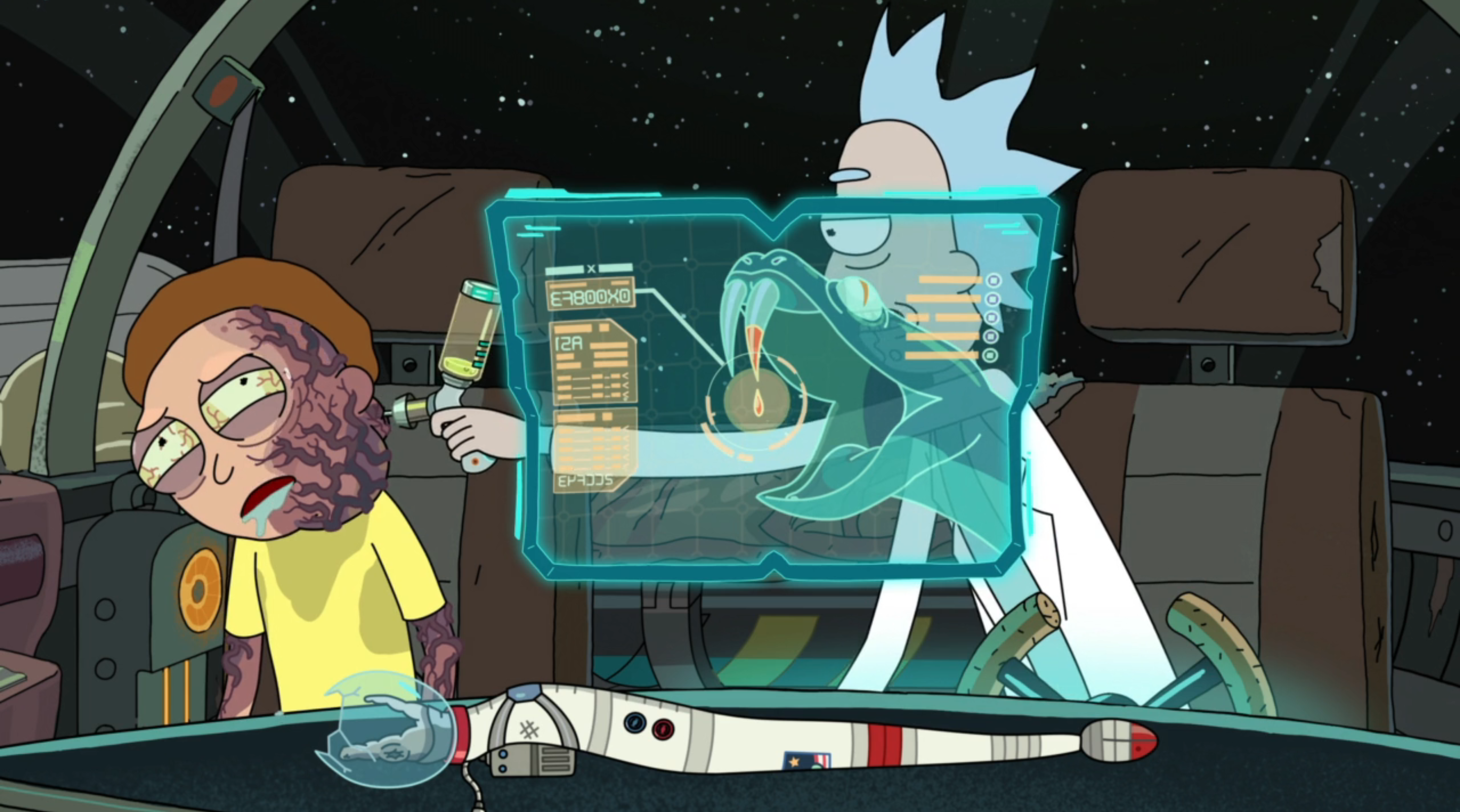
Even though Rick and Morty makes a point to clown on time travel as a common sci-fi trope, “Rattlestar Ricklactica” comes close with how it plays with themes from Terminator, except with snakes. A play on Battlestar Galactica, while the episode’s main plot revolves around Rick and Morty trying to revert a snake society back to normal after Morty brings an alien snake to their home planet, the subplot focuses on Jerry trying to handle an issue himself when Rick makes him slightly lighter than air so he can hang Christmas decorations. The underlying story in Rick and Morty’s adventure is how much Rick antagonizes Morty to prove a point, which would go on to become an even greater plot device in future episodes. —Jordan Rose
14. “The Vat of Acid Episode” (Season 4, Episode 8)
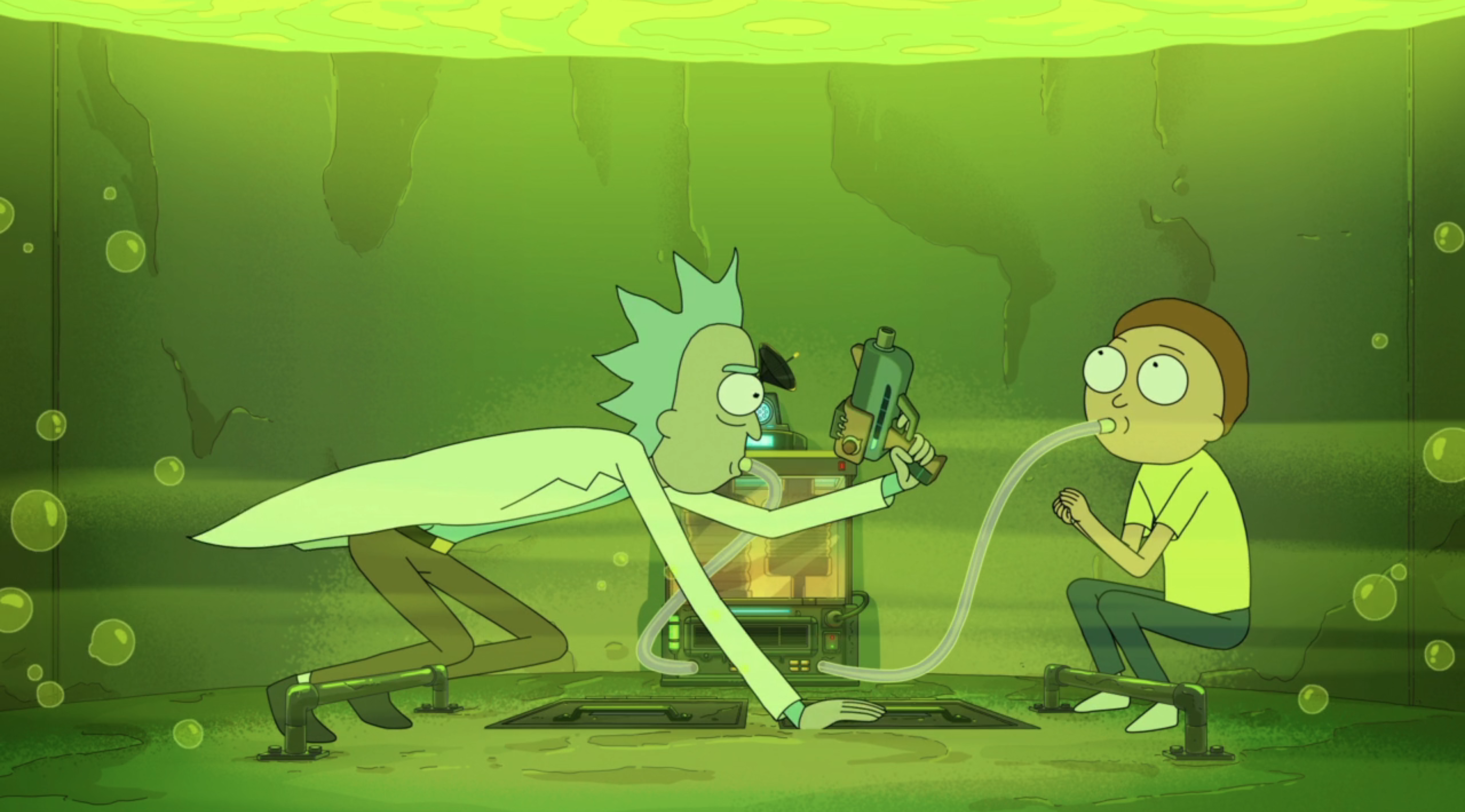
Rick and Morty often goes out of its way to show just how right Rick is about any given situation and how much smarter he is than everyone else in the room. The series mines a lot of comedy from this inherent premise, but few are as funny or crushing as the famous “Vat of Acid Episode.” When the titular duo set out to exchange crystals with some gangsters, the deal ends up going awry, forcing Rick and Morty to jump into a vat of acid. But it turns out the vat’s a fake and is really a pool (complete with breathing tubes) planted by Rick for the duo to stage their deaths and hide out in until the gangsters leave.
After insisting that the vat was a stupid idea, Morty provokes Rick into making him a video game-like “save point” device that allows him to save his life at any point and reset back to it to make a different decision. After a heartbreaking lesson at the hands of Jerry’s buffoonery, Rick takes things one step further and absolutely punishes Morty for deriding his vat of acid. It’s the ultimate insult to injury, resulting in an outlandish and hilariously dick-ish moment from Rick that proves, once and for all, that you don’t mess with the best. —William Goodman
15. “Childrick of Mort” (Season 4, Episode 9)
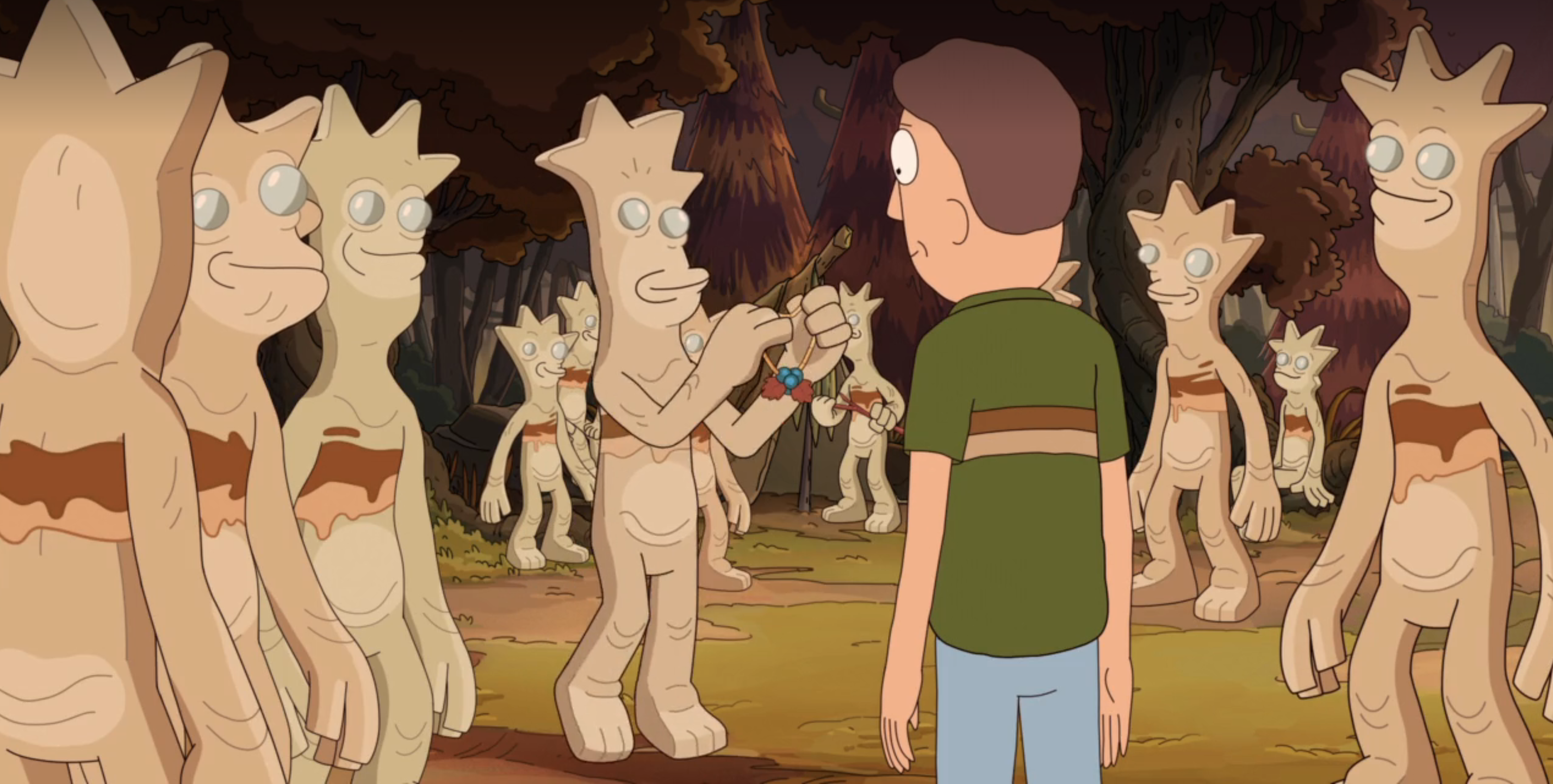
Rick and Beth’s relationship has always been contentious, but “Childrick of Mort” finds the father and daughter working together in the most Rick and Morty way possible after the family finds out that Rick somehow got a planet pregnant. Besides the hilarious grudge match that Rick has with a godlike creature and Jerry’s brief moment in the sun as the patriarch to Rick’s planet babies, the episode really centers around parenting and Beth projecting how she wished Rick would have been around for her. There’s also the added irony of Summer and Morty being left to their own devices during the episode, leading them to inadvertently, and irresponsibly, saving Rick. —Jordan Rose
16. “Mort Dinner Rick Andre” (Season 5, Episode 1)
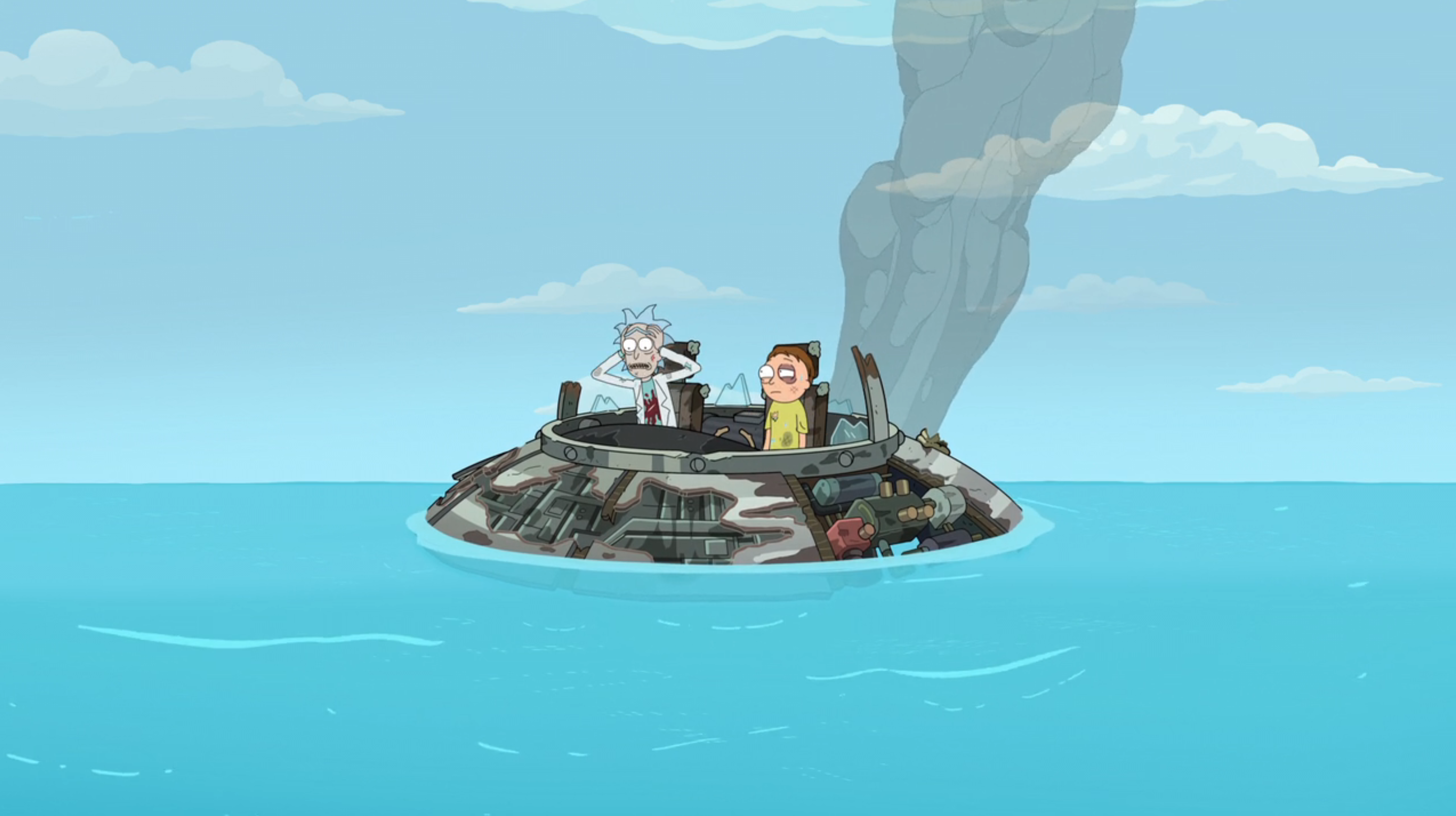
There’s so much that’s great about “Mort Dinner Rick Andre,” from the cold open of Morty calling Jessica in his dying moments, to the hilariously long-running rivalry between Rick and Mr. Nimbus that we’re just being let into, and the subplot of Morty setting an entire civilization into motion all because he’s trying to impress a girl. The Season 5 opening has a perfect balance of zany sci-fi shenanigans and legitimate storytelling. Why can Mr. Nimbus control the police? How did he and Rick meet? Will Jessica ever be the same again after being trapped in a futuristic Narnia-like society? The best thing about Rick and Morty is that even though these questions seem important in the moment, they probably won’t matter at all in the next episode. —Jordan Rose
17. “A Rickconvenient Mort” (Season 5, Episode 3)
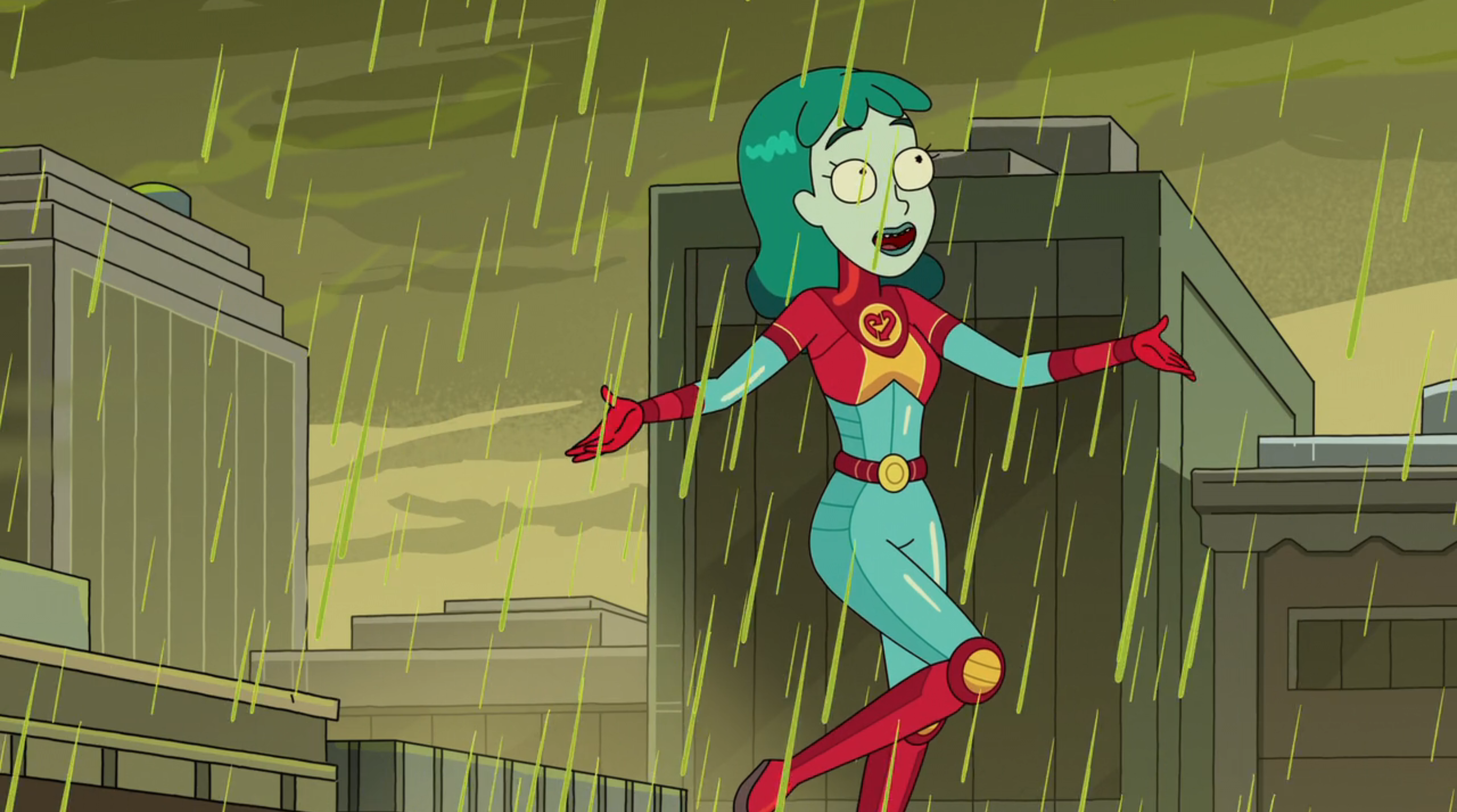
Of course everyone loves when Rick and Morty are on adventures together, getting into trouble and doing dumb shit. But some of my favorite moments from the franchise come from when Morty is off on his own, getting into his own trouble without Rick, and struggling to find his way out of it. That’s exactly what goes down in “A Rickconvenient Mort,” where Morty falls in love with an eco-friendly superhero and gets into a feud with the folks that created her. While Morty is dealing with that and quickly dealing with the realization that he is in over his head, Rick and Summer are on an adventure of their own, galavanting through the universe and getting into just about as much ridiculous trouble as you can imagine. —Ben Felderstein
18. “Rickternal Friendshine of the Spotless Mort” (Season 5, Episode 8)
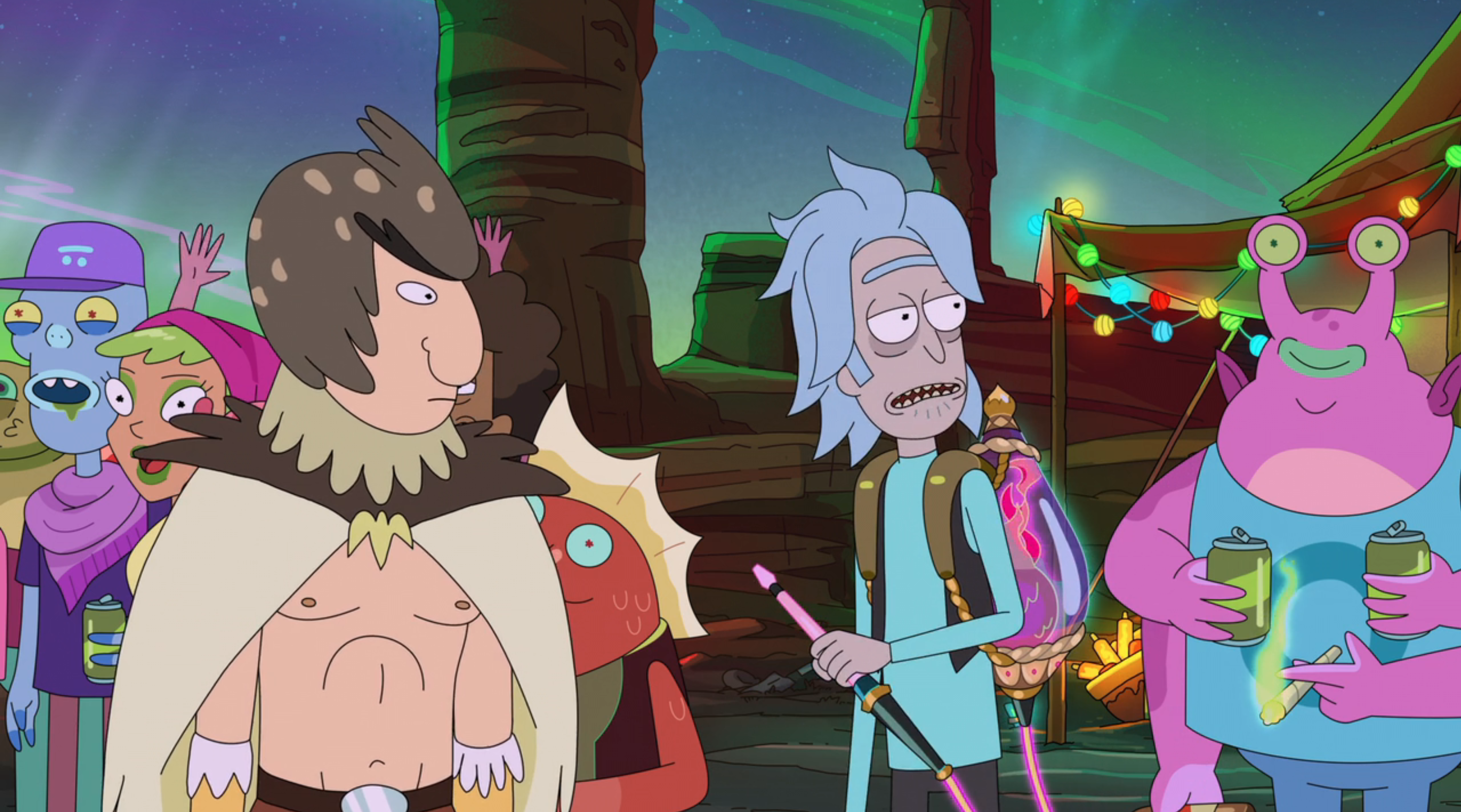
A lot of the meta-commentary in Rick and Morty revolves around how much Rick is against normal main character backstories. He makes fun of the idea of a “tragic backstory” in the first episode of Season 3, “The Rickshank Rickdemption,” but after the show progressed, it became increasingly obvious that Rick wasn’t an emotional mad genius and did have ties to his past, which come to a head in “Rickternal Friendshine of the Spotless Mort.” Birdperson was introduced as one of Rick’s best friends in Season 1, and this episode finally shows us why as Rick attempts to restore his longtime companion’s corrupted mind. This episode is equally endearing and depressing because it shows that Rick tries to control everything in his life— and despite all of his powers, there are some things he can never undo, like disappointing the people closest to him. —Jordan Rose
19. “Rickmurai Jack” (Season 5, Episode 10)
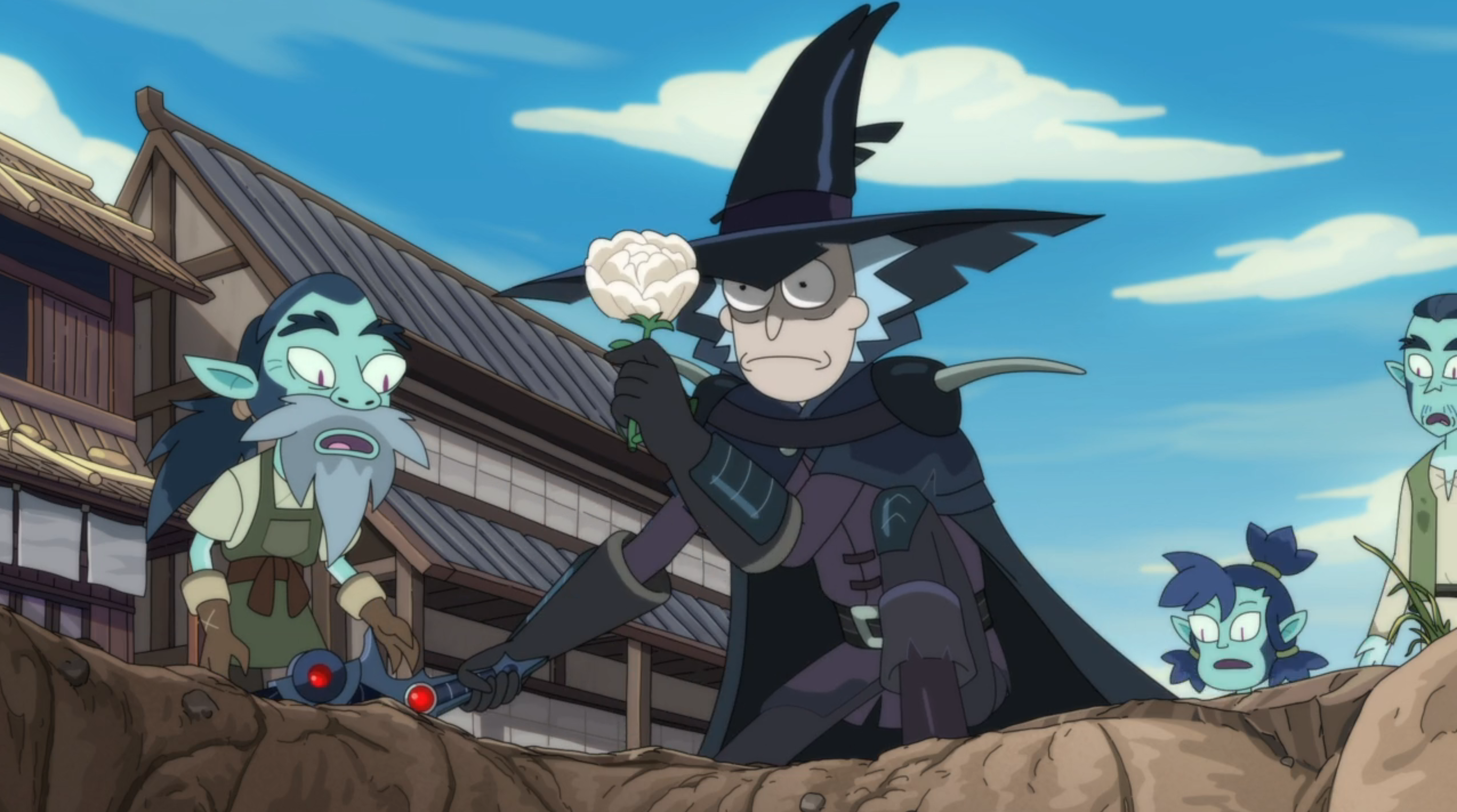
Despite teasing it often, Rick and Morty doesn’t go heavy on its serialization, preferring to operate in a more episodic nature with each episode being distinctly memorable and uniquely identifiable. That approach works; after all, you’re currently reading a list of the show’s best episodes. But when the series does decide to harvest sown seeds, it usually does so to great effect. Case in point: “Rickmurai Jack,” the second of a dual-part finale of the fifth season, which only picks up on lingering plot threads about the Council of Ricks and provides a moving backstory to Rick. It’s one of those installments that could only be accomplished this late in a show’s lifespan, as it mines its own story to shocking and entertaining depths. Oh, and it also features Rick becoming a Ronin with two crow sidekicks on some real anime shit. —William Goodman
20. “Night Family” (Season 6, Episode 4)
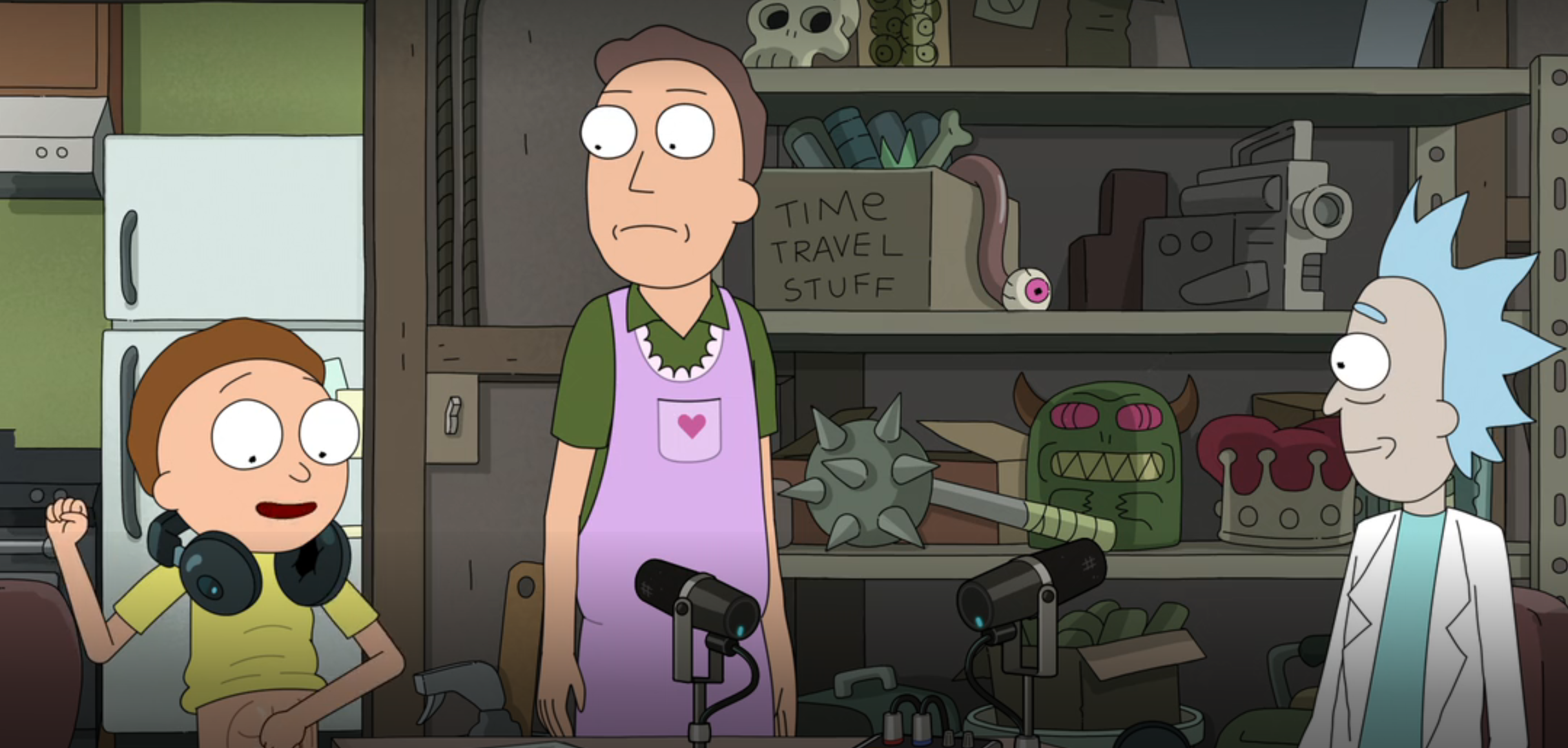
What if you could sleepwalk and get some productive stuff done? That’s the crux of “Night Family,” easily one of Season 6’s highlights. When Rick introduces his new device that can make unconscious bodies do chores while sleeping, the Smith family immediately jump at the opportunity and let their night people perform menial and annoying tasks while they sleep. Until, that is, the night family gets tired and revolts, hiding the device and taking sedatives to gain full control. It’s a simple yet effective high-concept premise that soars thanks to the fact it focuses on the entire Smith family, becoming a wonderful ensemble showcase. —William Goodman
